Pricing Guides & Dictionary of Makers Marks for Antiques & Collectibles

COLLECTIBLE DELFT POTTERY and DELFTWARE:
Identifying and Appraising Guides
Join the most updated and complete collectibles research online - Learn more...
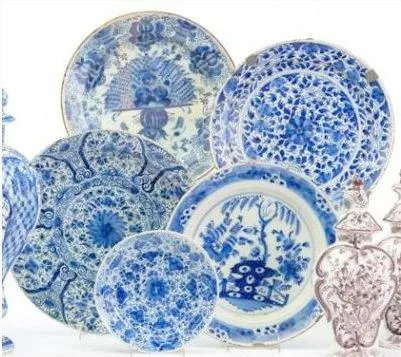
DELFT POTTERY and the term DELFT-WARE refer to a specific decorative style that originated in the town of Delft in Holland. Potteries in the area making mostly simply-shaped earthenware vases, urns, plates or tiles date as far back as the early 16thC. Most Delftware is Blue & White Chinoiserie designs and was in direct imitation to the widely popular Chinese imports to Europe of that era. Some examples are Polychrome (i.e. of many colors), but almost always on a classic thick white glazed background. Deft Chinoiserie was a Europeanized form of Chinese exports of the time and most such items were designed or modeled with Western tastes in mind.
Delft as a style is still quite popular these days. Pretty souvenirs from Holland or other decorative objects are produced in droves. Although Delft’s Dutch origins suggest that this was the only place where Delftware was produced, this is far from true. Potteries in other countries were also very prolific and early adopters of this style, mostly ca mid-18thC onwards, and especially in the UK - termed English Deftware, very often in polychrome designs - but also in France and Italy. Even Japanese potters & kilns that had already developed a rich industry using porcelain, which by default is superior to earthenware, imitated designs made in Holland and exported them to Europe. Nowadays, most Delft designs are typical scenes or shapes that are reminders of Holland’s countryside and Dutch folklore. Many of these are actually mass-produced in China and may have had some decorative finishing touches at one of the numerous workshops near their place of sale. Such examples of Delftware are specifically destined for the tourist trade and in most cases are of good quality, but not of any significant appraisal value.
However, some companies have continued the tradition of making pottery in the old manner, both in using tested techniques or materials and also in the true ancient Delft design style. The vast majority of these are often accurate and fine reproductions of specimens found in Museums or fine private collections and very desirable by collectors, even though some may be fairly recent. Such items are clearly marked, often including the Artisan’s initials or other information or a year symbol, and can be readily identified using our Ceramics makers’ marks guide. Additionally, some Delft-ware, particularly those made in France around the mid-to-late 19thC, were marked with logos or symbols (usually letters or initials) that are almost identical to those used by authentic potteries in Delft some 200 years earlier and which were by then extinct. These antique French Delft marks are also tabulated and explained in our Ceramics marks guides.
As expected and amply observed in today’s antiques or collectibles market, the Delft style has permeated its reach into objects that are quite diverse. For example, we often see Delft-styled clocks, porcelain Delft figurines, furniture inlaid with Delft-themed porcelain tiles or plaques, elegant chinaware & tableware, and all sorts of other decorative or utilitarian items of a distinctly clear Delft flair or motif. Some of these were made ca 19thC, but the vast majority hail from relatively recent times and are often mass-produced. Additionally, these are porcelain, not earthenware like the original antique examples, and have a much brighter sheen and translucency as compared to the original 16 – 18thC Delft specimens.
Appraisal values for Delft pottery or Deflt-Ware depend on a few basic specific factors, including age, provenance, size, and condition. Since the Delft style is quite uniform, their appeal and beauty is somewhat standardized and most designs are similar, at least at first glance.
Unlock the true value of your collection with our comprehensive research guides from identifying makers' marks to appraising all kinds of antiques and collectibles, including items featured in this article.
Our up-to-date information will give you an accurate understanding of your items' worth. Don't miss out on this valuable resource - visit our research tools today!
In addition to some examples shown below on this page, you can also search our price guide for your own treasures.
Examples of related items from our Price Guides
-
 Delft Canister Set, Bowls and Flower Fro
[more like this]
Delft Canister Set, Bowls and Flower Fro
[more like this]
-
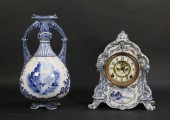 ANSONIA DELFT ROYAL BONN CLOCK & DELFT J
[more like this]
ANSONIA DELFT ROYAL BONN CLOCK & DELFT J
[more like this]
-
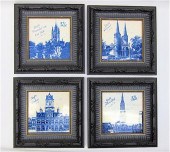 FOUR FRAMED DELFT BLUE & WHITE PORCELAIN
[more like this]
FOUR FRAMED DELFT BLUE & WHITE PORCELAIN
[more like this]
-
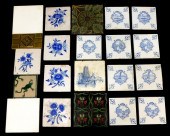 TWENTY-ONE ASSORTED CERAMIC TILES, INCLU
[more like this]
TWENTY-ONE ASSORTED CERAMIC TILES, INCLU
[more like this]
-
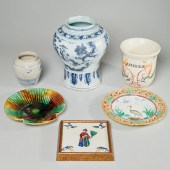 MAJOLICA & DELFT STYLE CERAMICS GROUP (6
[more like this]
MAJOLICA & DELFT STYLE CERAMICS GROUP (6
[more like this]
-
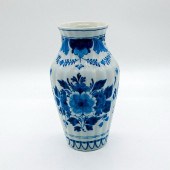 VINTAGE ROYAL DELFT VASE, BLUE PEONY BLO
[more like this]
VINTAGE ROYAL DELFT VASE, BLUE PEONY BLO
[more like this]
-
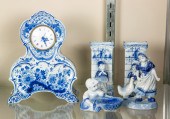 (LOT OF 5) DELFT BLUE AND WHITE CERAMICS
[more like this]
(LOT OF 5) DELFT BLUE AND WHITE CERAMICS
[more like this]
-
 TEN CERAMIC TILES, SOME POSSIBLY DELFT,
[more like this]
TEN CERAMIC TILES, SOME POSSIBLY DELFT,
[more like this]
-
 JOOST THOOFT & LABOUCHERE DELFT TILE MOS
[more like this]
JOOST THOOFT & LABOUCHERE DELFT TILE MOS
[more like this]
-
 A Delft figure of a rhinoceros, 9cm long
[more like this]
A Delft figure of a rhinoceros, 9cm long
[more like this]
-
 GROUP OF DELFT AND DELFT-TYPE PORCELAIN
[more like this]
GROUP OF DELFT AND DELFT-TYPE PORCELAIN
[more like this]
-
 3 PIECES DELFT POTTERY PLANTER & PAIR PL
[more like this]
3 PIECES DELFT POTTERY PLANTER & PAIR PL
[more like this]
There are many more auction results available to our members...





